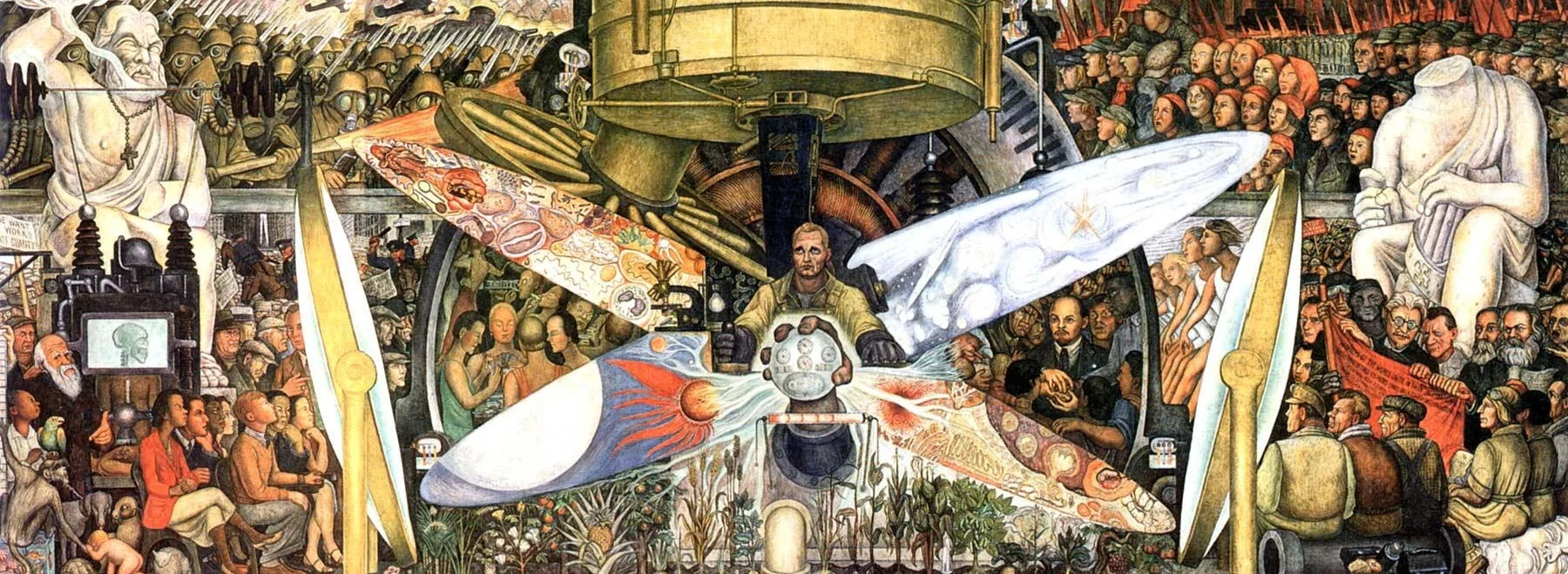As I was exploring the art of the Federal Arts Project/WPA, I noticed some similarities to the muralists of Mexico known as “The Big Three”: Diego Rivera, David Siqueiros, & Jose Orozco. I wanted to draw attention to the impact these artists had on the muralists of the WPA movement and some of their controversial work in the US. After the Revolution in 1920 Mexican Muralism was commissioned under the Mexican Government to reunify the country with the ideals of the revolution. This gained widespread recognition outside of the country, and the US was interested in what these murals had to offer. From both private and federal projects, these Mexican Muralist left a lasting mark on the American scapes.
Man, Controller of the Universe. Diego Rivera
This mural never saw completion due to the controversy it held over one prominent figure included in the piece. Having Lenin just right of the man at the crossroads, Nelson Rockefeller had the mural removed. Even David Siqueiros had his Americana Tropical mural destroyed due to its strong political and social message. Diego Rivera redid the mural in his home city in CDMX in the Palacio de Bellas Artes under the new name of Man, Controller of the Universe. But this didn’t stop him from doing later projects under the New Deal. In 1940 Diego Rivera completed the Pan American Unity mural in San Francisco.
The Epic of American Civilization. Jose Orozoco
Completed between 1932 and 1934, Jose Orozoco painted 24 Fresco panels in two movements. The first movement depicts the lives of the Native Americans before the Spanish conquest. The second movement is from the time of Cortez onto the new future after the Mexican Revolution. Because of the looking to the past, present, and future of this mural, this reflects the American idealism that came out of the WPA art movement. However, Jose Orozoco had more freedom in his political and social landscape than the American artists who had more restrictions in the WPA.
Society Freed Through Justice. George Biddle
One of the most influential artists of the WPA was George Biddle. He is also said to be one of the people that told President Franklin that the WPA needed art projects. Biddle was inspired and even studied under Diego Rivera. The influence can be seen in his mural Society Freed Through Justice in Washington DC. George Biddle was also influenced by Mexican art critic of the WPA Anita Brenner. Playing a pivotal role for the creation of the Federal Arts Movement, George Briddle used the influences of the Mexican Mural Movement that employed hundreds of artists in America.
Evolution of Music and Musical Instruments. Lucienne Bloch
One of the most famous female muralists would be Lucienne Bloch. She was one of the few mural artists that had prior training in this medium. As a muralist she was not only influenced by Diego’s technique but also his approach to social and political responsibility. She was interested in building harmony between ethnic groups. This is especially seen in her work in New York City. She was close to Diego and Frida and took the only photos of Man, at the Crossroads and many photos of the artists themselves.
Work Cited:
teachers.yale.edu/curriculum/viewer/initiative_05.02.09_u
en.mxcity.mx/2016/12/man-controller-of-the-universe/
hoodmuseum.dartmouth.edu/learn/k-12-educators/educator-resources/orozco-mural
archive.org/stream/newdealfineartsp00kalf/newdealfineartsp00kalf_djvu.txt
livingnewdeal.org/tag/mexican-art-and-the-new-deal/
digitalcommons.unl.edu/cgi/viewcontent.cgi?article=1005&context=sheldonpubs
livingnewdeal.org/projects/high-school-for-music-and-communications-mural-manhattan-ny/




